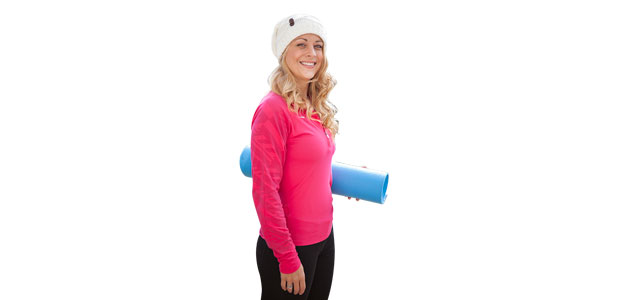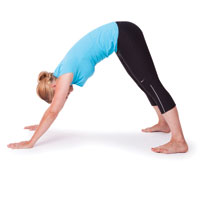
Feeling tired just thinking about all your holiday obligations? Energize yourself with our fatigue-banishing yoga exercises.
Fatigue. Nothing an extra-large dark roast coffee can’t beat, right? While that may be what some of us reach for to help us cope with the stressful and exhausting times of the holidays, experts propose a different solution. They suggest exercise, and you may be surprised at how little you need to feel the positive effects.
Exercise menu board
If exercise were sold in your local coffee shop, the menu board would likely read something like, “20 minutes of low-intensity exercise—the perfect blend of expending energy to create energy. Lightly blended, with just a hint of sweat, and 100% natural.”
Twenty minutes, three times a week—that’s all it took participants in a study published in Psychotherapy and Psychosomatics to feel less fatigued and more energized.
In another analysis, researchers pored over 70 different studies done on exercise and fatigue, and found that more than 90 percent of these studies showed that sedentary people who participate in a regular fitness program experience an increase in energy levels.
Energy begets energy
While exercise may seem like the last thing you want to do when exhausted, there is no denying that energy begets energy.
When my clients don’t want to exercise I like to tell them to make a deal with themselves beforehand: tell their “inner naysayer” that if, after 10 minutes of exercising, they still want to curl up in the fetal position, to give themselves the out and head back to the couch. However, in the 20 years that I have been telling people this, no one has ever stopped after 10 minutes.
Why? Because starting is the hardest part. Once you begin, the effects of exercise—including increased blood flow, quickened heart rate, intensified breathing, and the release of endorphins (our happy hormones) and dopamine (our pleasure hormones)—make us feel alive, awake, enthused, and ready to take on the day again.
What type of exercise?
It doesn’t take intense running or cycling to reap exercise’s energy-boosting rewards; something as simple as a 20-minute walk can turn things around energy- and mood-wise. Walk as often as you can, and if the weather permits it, take your walk outside. Nature is connected to our health; being cooped up in an office building or your home over the winter months can deepen feelings of fatigue and even depression, whereas being in nature can boost our moods.
However, just about any exercise will do the trick to offset your holiday fatigue. Whether it’s aerobic and gets your heart rate up (such as jogging or swimming), gentle (such as a hatha yoga or tai chi class), or anaerobic (such as weight training), each will give the boost we crave from caffeine, but with a plethora of health benefits.
Fatigue-fighting yoga poses
Yoga poses energize the body from the inside out, making yoga one of the best forms of exercise to fight fatigue.
|
Downward Dog This inversion pose will strengthen and revive the body.
|
 |
|
Warrior 1 Warrior poses work all the larger muscles of the lower body, creating a greater need for blood flow and energy to those areas.
|
 |
|
Wide Stance Spinal Twist Twists are thought to be stimulating and detoxifying, making this gentle spinal pose the perfect addition to your holiday exercise routine.
|
 |
|
Legs-up-the-Wall Elevating your legs is very therapeutic. In yoga it’s often done to help relax, aid insomnia, and release sore legs.
|
 |
4 simple tips to fight fatigue
Drink water
One of the symptoms of dehydration is tiredness. Although everyone is slightly different, a general guideline is to start your day with a glass of water and then aim for about 8 to 10 cups thereafter. One trick that I recommend (and use) is to wrap three coloured elastic bands around the bottom of your water bottle. Every time you finish a bottle and refill it, push one of the bands to the top of the bottle. This will give you a visual throughout the day of whether you are drinking your recommended intake of water.
Move your body
If you want to fight fatigue, 20 minutes of exercise three times a week has been shown to increase energy levels. However, to maintain better health, prevent weight gain, and keep the heart and lungs healthy, the Canadian Society for Exercise Physiology recommends a minimum of 150 minutes of moderate- to vigorous-intensity aerobic exercise each week, plus strength training at least twice each week.
Consider supplements
Naturopathic doctor Heli McPhie recommends to her patients vitamins C and B complex to help support adrenal function during the busy winter months (the adrenals enable our bodies to deal with stress), ashwaganda to help support sleep, and Siberian ginseng as a gentle energy tonic. Always check with your health care practitioner to make sure a supplement is right for you.
Relax
Deep breathing and meditation have been shown to aid in reducing stress levels, which in turn will help combat fatigue. All are easier said than done, though. Start with baby steps—find a quiet area in your home and sit comfortably for five minutes, with your eyes closed, simply focusing on your breathing.



































